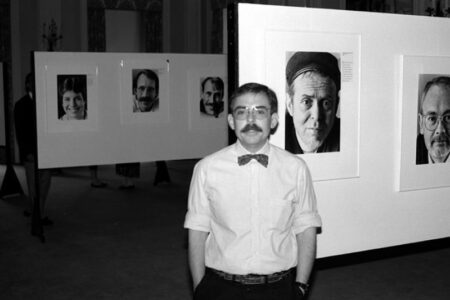
JIM WIGLER
PIONEER PHOTOGRAPHER
A Lifetime Focus on Gay Popular Culture
Jack Fritscher
Jim Wigler was born in Detroit in 1944. Upon moving with his Nikon to the wild art scene of 1970s New York City, he lensed a poetic Leonard Cohen and a dramatic NYPD cop who incarnated his fantasy of his erotic ideal. He worked professionally and significantly as assistant’s assistant to photographer Frances McLaughlin-Gill, the first female fashion editor under contract to Vogue. Taking a page from the female gaze of her book, Women Photograph Men (1976), he moved in 1979 to turn his gay gaze on San Francisco men. Trailing habits from New York, he joined in the high times of art, sex, drugs, and disco on Castro Street and Folsom Street before beginning his recovery in 1980.
During forty years, thousands of his photographs have appeared on the covers, centerfolds, and interior layouts of dozens of magazines including Bear, Honcho, and the legendary Drummer which in October 1982 launched Wigler’s nationwide reputation by publishing his immediately canonical photo series “Red Dog Saloon.” As an erotic documentarian of leathermen, he shot his deep-focus profiles most often on location in bars, playrooms, and Golden Gate Park. His popular rugged work was everywhere from magazines to hunk calendars for the “Castro Country Club” to his solo exhibits like Vietnam War Vets: Face to Face, Stars of the SFPD, and Faces of AIDS.
In Summer 1982, the Eagle bar in San Francisco hung his show, Raw Graphics, celebrating the men and spirit of 1970s kinky role-playing psychodrama. Wigler’s authentic photos, caused an erotic sensation among applauding leatherfolk. The series featured Gunner Robinson, his partner in their company aptly named RAW Graphics: RobinsonAndWigler. Leather-satyr Gunner was photo-graphed in the woods with guns and knives menacing two leather-hooded and bound men played by Karl Boyer and Larry Hunt, a model he shared with Robert Mapplethorpe who, two years younger than Wigler, at that same moment in New York, was shooting his own challenging fetish photos of masked men, guns, and knives.
Both photographers scared the horses. It was the first summer of Gay Cancer. People were already scared sexless. Self-appointed gays began to censor gay art and behavior the way they had attacked the 1980 film Cruising for its frightful straight gaze at gay culture. These iconoclasts demanded that the Eagle yank Wigler’s politically incorrect icons off the walls prefiguring the exact way the fundamentalist United States Senate would soon yank Mapplethorpe’s icons off the walls of museums.
What had been a pop-culture, esthetic, and timely queer inquiry into BDSM ritual and psychology—the erotic attraction-repulsion fetishes around death—was suddenly censored. Like Mapplethorpe, Wigler and his authentic 1980s cultural iconography were caught in the wrong place at the wrong time by panicked people who were reacting against everything erotic enjoyed during the AIDS-free 1970s. Undeterred, and not to be erased, Wigler undercut pretense, persisted with his truth, and survived the gay culture war.
Forging ahead to self-fund his Face of AIDS project, he shot dozens of erotic videos for companies such as Hot House and Bear magazine’s Brush Creek Media. When he snapped Gunner Robinson for his first of thirty-four Drummer covers (issue 57, October 1982), he joined a sleek Drummer peer group of cover photographers including Robert Mapplethorpe, Lou Thomas, Jim Moss, Victor Arimondi, Robert Pruzan, Rose de Castro, and Charles Gatewood; and he shot arguably some of the best covers international Drummer ever published.
Besides his knack for portraying perfectly shot and perfectly hot private guys, Wigler excelled at revealing something personally compelling in his roster of famous public icons like Donnie Russo, Michael Pereya, Guy Baldwin, Brian Dawson, Rob Marvin, Mike Torkildson, and Colt Thomas, the fifth International Mr. Leather, whom he made translucent and transcendent on Drummer magazine’s most beautiful cover. In fact, if ever there was one supremely perfect Wigler cover photograph, it is his color shot of the sun-drenched Colt Thomas on Drummer 126 (March 1989) that was published the week Robert Mapplethorpe died in a dark storm of censorship.
Wigler’s fin de siecle work is a graphic encyclopedia of the faces, facts, and fantasies of homomasculine leather culture from its gestation in Marlon Brando’s The Wild One in the 1950s, to its liberation in the 1970s, to its disruption in the 1980s, to its resurrection in the twenty-first century.
It is precisely the frisson of Wigler’s erotic art that adds even more living breathing humanity and celebration to his elegaic Faces of AIDS.
—Jack Fritscher, Editor-in-chief, Drummer Magazine
Jim Wigler shot the cover photographs for 34 Drummer issues which may be viewed at http://online.flipbuilder.com/qquj/oyii/mobile/index.html:
57, 59, 60, 62, 63, 66, 67, 69, 70, 71, 74, 75, 109, 110, 122, 126, 132, 133, 136, 137, 139, 141, 142, 143, 146, 147, 148, 150, 151, 152, 181, 202, 209,
210

